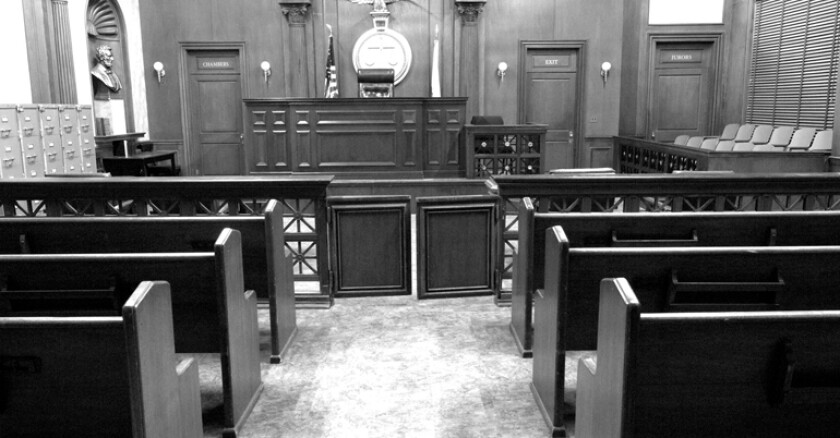Making these blended experiences run smoothly requires plenty of work, beyond simply handing judges laptops and accounts with videoconferencing services. The hearings themselves are the most visible piece of the puzzle, but plenty more preparatory and behind-the-scenes effort goes into allowing everyone to securely and smoothly connect, share evidence and more, said Snorri Ogata, CIO for the Los Angeles County Superior Court.
“Hybrid hearings are more than just putting up cameras and letting people talk,” Ogata said. “There’s a whole system around it.”
During the recent National Center for State Courts (NCSC) Court Technology Conference 2021, he shared Los Angeles County’s journey outfitting courtrooms for hybrid sessions, trying in-house and commercial conferencing platforms and responding to unanticipated equity issues.
TAILORED COURT PLATFORM
Los Angeles County at first launched some types of trials on a custom videoconferencing system, made in partnership with a vendor. The tailored platform allowed the court to design features around unique judicial requirements.
The court system also sent individuals automated reminders about their upcoming hearings and had them authenticate themselves with unique court ID and PINs, helping judges be certain who was joining, according to Ogata and L.A. County Superior Court Executive Officer Sherri Carter.
It also let judges view more useful details about users. Commercial platforms’ displays often show the phone numbers, rather than names, of individuals who connect by dialing in. But Ogata said it was important for judges to be able to quickly know the individual’s name, role in the proceedings and the associated case number. Integrating a platform with the court’s case management system delivered that level of detail.
COMMERCIAL OFFERING
But despite all these features, the county’s custom system fell short, with courts discovering the audio and video quality suffered under the high volume of use, Ogata said.
“[We] had this really wonderful, highly tailored capability that unfortunately couldn't deal with packet loss and jitter and couldn't deal with a scale of 5,000 participants a day,” Ogata said.
This led to a switch to a commercial solution that could better accommodate high traffic and which was already familiar to many users, reducing training needs.
That change hasn’t been without bumps; it required forgoing the customized features and has left the court caught off guard when the company updates its software to change features — which in turn impacts the training the court must offer.
“When you have 585 courtrooms and all the employees that are supporting those, you need to have advance notice and training and coordination and communication, and sometimes notification to the unions about what's going to change,” Carter said.
Ogata said the team is now looking to blend the two approaches, by working with the APIs underpinning the commercial platform to modify it and add back in court-specific features and new capabilities.
INSIDE THE PHYSICAL COURTROOM
Making hybrid work means not just getting the right software, but also the courtroom hardware so that everyone at home and in-person can see and hear each other.
Ogata said courts had to deal with a slew of practical concerns, from determining where to add cameras so everyone can see who is speaking to finding the least echoey method for capturing courtroom audio (digital signal processing — or DSP — microphones, proved helpful).
The resulting equipment setups also led to cables snaking all over the courtroom, creating tripping hazards, Ogata said. The team ultimately found a vendor that could install modular flooring that encases the wiring, keeping it tucked away below foot-level.
PRE-TRIAL PREP
Plenty of work also had to be done to prepare participants for hybrid sessions.
Attorneys who were no longer visiting the courthouse to pick up case files needed digital ways to access them, and participants needed to be trained on the videoconferencing technology. Ogata said the county pushed out training materials advising best practices — such as encouraging wearing wired headsets rather than relying on laptop microphones — and offered regular time slots during which judges and lawyers could play around in and test out the videoconferencing platform, while staff were on hand virtually to answer questions.
Once attorneys got comfortable, they’d teach their clients how to use the technology, too.
EQUITY IMPACTS
As they charted the technology transformations, Ogata and Carter became aware of nuances of hardware and software setups that can particularly impact people with translation needs or hearing difficulties.
Courtroom cameras need to capture speakers’ faces to support participants who read lips, for example. Deaf and hard-of-hearing individuals also need the videoconferencing platforms to allow for pinning ASL interpreters’ videos to always show up on the first page of the display, a capability Carter said will be added in the future. Many platforms are instead designed to prioritize showing whoever’s speaking out loud and may bump other participants — like interpreters — off screen.
Courts also need to be sensitive to different participants’ comfort with and access to technology, but it so far hasn’t found lack of device access to be an issue for participants. Most residents own a smartphone, Carter said, and they also can visit a library or the courthouse to on-site devices or dial in from a regular landline phone.
Residents’ widespread smartphone ownership has not resulted in a strong preference for using video during remote hearings, however, Ogata said. Findings examining September 2020 to August 2021 trends showed more than 50 percent of remote participants choosing to dial in to hearings with audio only.
That trend may demonstrate a need for low-cost services as much as for low-tech friendly ones, however: L.A. County initially funded its technology adoption by charging participants fees to join, with video costing more than audio, Carter said. (Fees waivers were also available, she said). The county saw the rate of video use rise once the two prices were equalized. One-time pandemic relief funds now allow the court to offer remote hearings for free, as of early September 2021.









